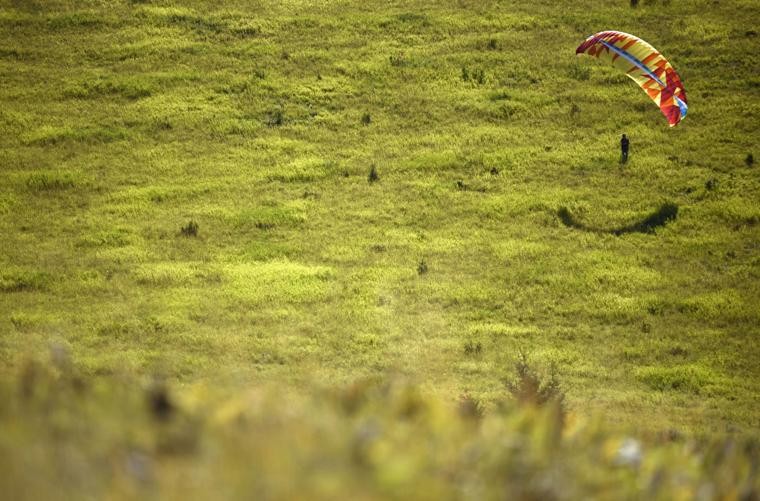BOZEMAN, Montana — Some people really do fly.
Bozeman’s 5 p.m. traffic thinned as a white van with a “Fly Life” bumper sticker turned on a two-lane road winding toward Bear Canyon. The van pulled to the shoulder and four guys with 35-pound packs made their way to a tree-hidden path.
They talked wind and thermo activity, but heavy breathing replaced words on the steep climb to one of Bozeman’s best unofficial training hills for paragliding.
They crossed out of the tree line to a view of town just in time to see a man running toward the hill’s drop, his head down, his chest tight and arms to his side like an upside down V.
“You’re running like a torpedo towards the hill, which never feels right,” paragliding instructor Ryan Schwab told his students as they watched.
Then a nylon, parachute-like wing trailing behind the man caught the wind, lifting his feet from the ground.
“But you’ll be flying before you know it,” Schwab said with a grin.
Paragliding includes a harness suspended under fabric. It’s a sport that relies on two powerful sources: wind and gravity.
The latter calls for a high starting point, something Bozeman has plenty of.
The crew gathered Tuesday were part of Fly Life Paragliding’s school for the P2 certification, which qualifies students to fly on their own through the U.S. Hang Gliding and Paragliding Association.
“It’s basically like a driver’s license to fly,” said student Elias Athey, 23.
Athey was preparing for his first flight, which he’d do alone after three ground lessons on how to control the wing.
The Bear Canyon launch is small compared to other paragliding take-off points. There, pilots can fly between 300 and 400 feet above their landing zone.
Though there’s plenty of access, it’s a sport with a high entry cost.
Prices for a complete set of gear range from $3,000 to $6,000, according to www.paragliders.com. Like most sports, the lighter the gear, the higher the price.
It’s also pretty important to know how to run off a mountain attached to a collapsible contraption and live, which means wannabe pilots need to factor in the price of lessons.
Nicolette Kleppelid, 22, said she put about $1,800 into paragliding school and $3,100 toward her wing. Fly Life provides the gear through its courses, giving students time to see whether they’ll buy their own wing.
Kleppelid said it’s a lot of money upfront, but more than 40 flights in, she’s among the minority in Bozeman that can take to the skies when the weather is right.
“Now it’s about upkeep, I can fly pretty much for free,” Kleppelid said.
Most people on the hill Tuesday found paragliding through a friend or another sport.
John Hosemann, owner of Fly Life, said he was rock climbing a few years ago when he looked up.
“I watched somebody fly off the mountain and thought, ‘forget the hike down, I want to be that guy,’” Hosemann said.
Hosemann is five years into paragliding, and his school is in its third season.
Hosemann said business got busy enough it was time to bring on a second instructor, which is how Schwab joined the team.
In a state where mountain sports compete for time and money, Schwab said paragliding stands out.
He said while it’s nice to learn the sport in the summer, it’s not tethered to seasons.
He recently picked up a speed wing, which allows the pilot to stay close to the ground. Schwab is learning how to pair his new wing with skis in the winter to alternate from the slopes to the sky.
Schwab said unlike hang gliding where wings are held in place, stretched across a metal frame, paragliding gear packs down to hike with or store. The sport doesn’t call for a plane like skydiving and instead of a free fall, a paraglider can cross mountain ranges if weather plays along.
Plus, there’s plenty of room in the sky.
“I think pretty much every child has a dream to fly like a bird and this is the best way to do it,” Schwab said.



